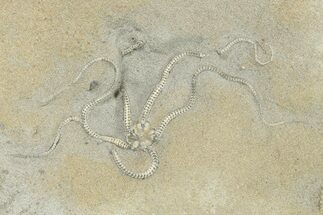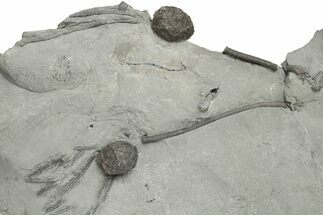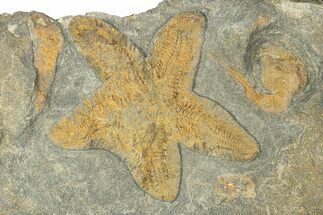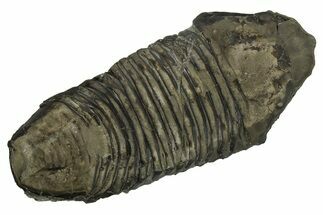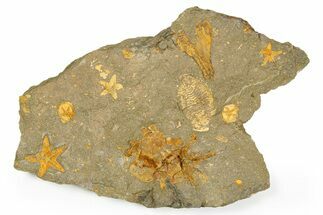This Specimen has been sold.
2.8" Silurian Fossil Starfish (Protaster) - New York
This is a beautifully preserved fossil starfish of the genus Protaster. The longest measurement of this specimen is 2.8", and it's nicely centered on 4.5 x 4.2" slab of shale. It comes out of the Rochester Shale in Middleport, New York. You won't find many starfish from this site available on the market.
It comes with an acrylic display stand.
It comes with an acrylic display stand.
Caleb’s Quarry is in the Rochester Shale Formation, which is a primary source of over 200 richly detailed species that tell the ecologic story of the Early Silurian. This famous strata is known for its especially beautiful and rare assemblage of echinoderms. The calcareous mudstones and grainstones were transported from the relic Appalachian Mountains, which were uplifted and then eroded into the shallow but deepening warm seas of the Atlantic foreland basin during the Early Silurian.
While the rocks around Lockport, NY have been worked for trilobites since the 1830s, the opening of Caleb's quarry in 1991 has significantly added to the quantity and quality of the material available. Working this quarry is unquestionably difficult since it spends much of the year under water. Many hours of detailed preparation under microscope are required to extract and repair the trilobites found there.
Brittle stars are seafloor denizens belonging to the genus Protaster. These echinoderms are ornamented with flexible, whip-like arms that lurched them across the sea floor: one arm would have pressed ahead, while the other four acted as two pairs of opposite levers, thrusting the body forward.
Protaster is in the class Ophiuroidae, which is closely related to starfish. The ophiuroids diverged in the Early Ordovician, about 500 million years ago, resulting in over 2,000 species of brittle stars living today. The Rochester Shale is known for the excellent preservation of Protaster detail in its Lower Silurian strata (425 mya). They often fell apart after death, making a cluster of intact specimens a rare discovery.
There are several fascinating details regarding the Ophiuridoid body plan:
A brittle star's skeleton is made up of embedded ossicles, which are microcrystals of calcite arranged in a three-dimensional lattice known as a stereom. Occicles fuse together into an armor-like test that forms part of the endoskeleton.
The crystals and the spaces between them produce a light and tough honeycomb structure.
Modern Ophiurides establish that Protaster had no eyes or other specialized sense organs. However, they likely had several types of sensitive nerve endings in their epidermis.
Their tube feet might have sensed light as well as odors.
The disk of Protaster contains all of the internal organs that conducted digestion and reproduction.
The underside of the disk contains the mouth, which is also the anus. Ingestion and egestion occur in the same area.
While the rocks around Lockport, NY have been worked for trilobites since the 1830s, the opening of Caleb's quarry in 1991 has significantly added to the quantity and quality of the material available. Working this quarry is unquestionably difficult since it spends much of the year under water. Many hours of detailed preparation under microscope are required to extract and repair the trilobites found there.
Brittle stars are seafloor denizens belonging to the genus Protaster. These echinoderms are ornamented with flexible, whip-like arms that lurched them across the sea floor: one arm would have pressed ahead, while the other four acted as two pairs of opposite levers, thrusting the body forward.
Protaster is in the class Ophiuroidae, which is closely related to starfish. The ophiuroids diverged in the Early Ordovician, about 500 million years ago, resulting in over 2,000 species of brittle stars living today. The Rochester Shale is known for the excellent preservation of Protaster detail in its Lower Silurian strata (425 mya). They often fell apart after death, making a cluster of intact specimens a rare discovery.
There are several fascinating details regarding the Ophiuridoid body plan:
SPECIES
Protaster sp.
LOCATION
Middleport, New York
FORMATION
Rochester Shale
SIZE
Plate: 4.5 x 4.2", Starfish: 2.8" wide (longest measurement)
CATEGORY
SUB CATEGORY
ITEM
#232056
We guarantee the authenticity of all of our
specimens. Read more about our
Authenticity Guarantee.
specimens. Read more about our
Authenticity Guarantee.
 Reviews
Reviews

